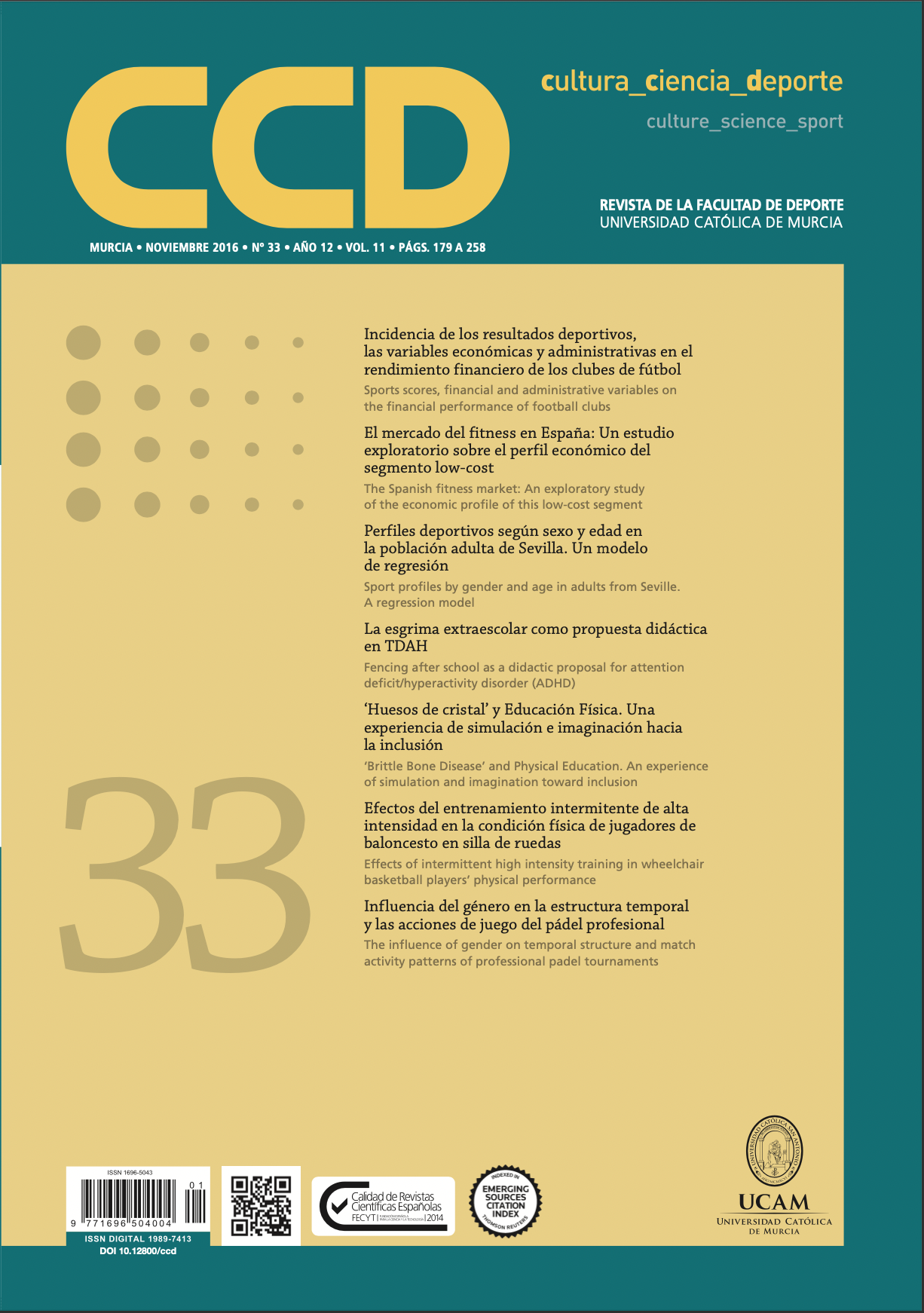Efectos del entrenamiento intermitente de alta intensidad en la condición física de jugadores de baloncesto en silla de ruedas. (Effects of intermittent high intensity training in wheelchair basketball players’ physical performance).
DOI:
https://doi.org/10.12800/ccd.v11i33.768Resumen
El objetivo de este estudio fue analizar los efectos del entrenamiento intermitente de alta intensidad (EIAI) en el rendimiento físico, las respuestas fisiológicas y la percepción subjetiva del esfuerzo en jugadores de baloncesto en silla de ruedas (BSR). Para ello, 12 jugadores masculinos (32.6 ± 10.7 años) de primera división de la Liga Española participaron en este estudio. La batería de test (sprint en 5 y 20 m, sprint con arrastre de peso en 5 y 20 m, test de cambio de dirección y test de resistencia multi-stage fitness test –MSFT–) se realizó en una única sesión midiéndose antes (T1) y después (T2) del programa de entrenamiento de EIAI. El tiempo en 5 m en T2 fue un 7.14% significativamente mayor (p < 0.05, d = 0.88, alto) que en T1. No hubo diferencias significativas en el tiempo en 20 m ni en el sprint con arrastre de peso en 5 y 20 m ni en el test de cambio de dirección. Tampoco se obtuvieron diferencias en la distancia recorrida, la frecuencia cardiaca máxima (FCmax), la concentración de lactato sanguíneo (LA) y la temperatura timpánica. Además, aunque no fue significativo, se observó un mayor esfuerzo percibido en el T2 respecto al T1, tanto a nivel respiratorio (RPEres, 16%, d = -0.64, moderado) como a nivel muscular (RPEmus, 9%, d = 0.50, moderado). El programa de EIAI de 10 semanas no produjo ninguna mejora en jugadores de BSR, incluso disminuyó un 7% el rendimiento en el sprint en 5 m.
Palabras clave: Paradeporte, sprint, fuerza, agilidad, resistencia.
===
Abstract
The purpose of this study was to analyze the high intensity intermittent training’s (HIIT’s) effects on physical performance, physiological responses and perceived exertion effort (RPE) in wheelchair basketball players (WB). Twelve male WB players (32.6 ± 10.7 years) from the first division of the Spanish League participated in this study. The battery of tests (sprint in 5 and 20 m, sprint with dragging weight in 5 and 20 m, agility T-test and multi-stage fitness test –MSFT–) was carried out in the same session. The players performed the battery of tests one week before (T1) and one week after (T2) the HIIT’s training program. The time for 5 m in T2 was 7.14% significantly higher (p < 0.05, d = 0.88, high) than in T1. There were not significant differences between T1 and T2 in the performance of 20 m sprint, nor in 5 and 20 m sprint with dragging weight, nor in the ability to change of direction. Moreover, there were not significant differences in distance covered, maximum heart rate (HRmax), blood lactate concentration (LA) and tympanic temperature. Even though the differences were not significant between T1 and T2 in RPE values, a higher perceived exertion effort was observed in the T2 compared to T1, in both respiratory (RPEres, 16%, d = -0.64, moderated) and muscular level (RPEmus, 9%, d = 0.50, moderated). The HIIT’s program of 10 weeks did not produce any improvement in WB players, actually, they diminished 7% of their performance in the 5 m sprint.
Key words: Para-Sport, sprint, strength, agility, endurance.
Descargas
Publicado
Cómo citar
Número
Sección
Licencia
Los autores que publican en esta revista están de acuerdo con los siguientes términos:- Los autores conservan los derechos de autor y garantizan a la revista el derecho de ser la primera publicación del trabajo al igual que licenciado bajo una Creative Commons Attribution License que permite a otros compartir el trabajo con un reconocimiento de la autoría del trabajo y la publicación inicial en esta revista.













